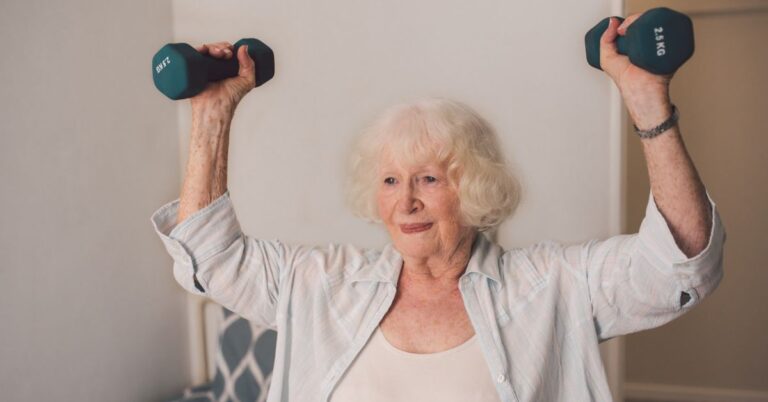Over 35? Here’s Why Strength Training Is Your Anti-Aging Superpower
Think aging means slowing down? Think again. Recent research reveals that one of the most overlooked keys to living longer, aging stronger, and feeling better after the age of 35 is not a fancy supplement or restrictive diet, but rather strength training.
Despite its well-documented benefits, most adults over 35 still prioritize cardio or avoid resistance training altogether. However, skipping the weights could be a significant mistake.
Building and maintaining muscle isn’t just about aesthetics; it’s now recognized as a crucial longevity strategy with benefits that extend far beyond the gym. Experts agree that it’s time to reframe strength training not just as exercise but as preventive medicine for aging bodies.
Expert Insight: “Muscle Is Metabolic Gold”
“After the age of 30, if we remain inactive, we begin to lose muscle mass at a rate of about 3 to 8% per decade,” explains Dr. Gabrielle Lyon, DO, a functional medicine physician specializing in muscle-centric medicine.
“This loss, known as sarcopenia, significantly contributes to the aging process, frailty, and metabolic decline.”
Dr. Peter Attia, a longevity specialist and author of the book “Outlive,” concurs: “Muscle mass is the most significant predictor of longevity. To age well, strength training is an indispensable component.”
Study Findings: Strength Training Is Linked to Lower Mortality Risk
Numerous peer-reviewed studies have confirmed the longevity-boosting effects of resistance training:
- A 2022 meta-analysis published in British Journal of Sports Medicine found that adults who did 30–60 minutes of strength training per week had a 10–20% lower risk of all-cause mortality, cardiovascular disease, and cancer compared to those who didn’t.
- Another study in Preventive Medicine revealed that grip strength a proxy for overall muscle strength—was a strong predictor of healthy aging and independence in older adults.
- Resistance training has also been shown to improve insulin sensitivity, reduce belly fat, boost bone density, and enhance brain function all factors linked to healthy aging.
CDC: Physical Activity and Health
Public Health Impact: Why Muscle Matters After 35
As we age, muscle mass naturally declines unless we take action to preserve it. This decline can lead to:
- Reduced mobility and balance
- Increased risk of falls and fractures
- Slower metabolism and weight gain
- Higher risk of type 2 diabetes and heart disease
Strength training is crucial for older adults’ independence, energy, and chronic disease prevention, yet only 23% of U.S. adults follow the recommended muscle-strengthening guidelines, according to the CDC.
How to Start Strength Training Over 35 (Even If You’re a Beginner)
You don’t need a gym membership or heavy weights to reap the benefits. Here’s how to ease into it:
1. Start with Bodyweight Basics:
- Squats, lunges, push-ups, and planks build functional strength
- Resistance bands or light dumbbells can add variety
2. Aim for 2–3 Sessions Per Week:
- Focus on compound movements that target multiple muscle groups
- Include rest days for muscle recovery
3. Don’t Skip Protein:
- Combine strength training with adequate protein intake (around 1.2–1.6g/kg of body weight per day) to support muscle repair and growth
4. Work With a Trainer:
- If you’re unsure where to begin or have injuries, consult a certified trainer or physical therapist for a tailored plan
Healthline: How to Build Muscle Safely After 40
Bonus Benefits: Beyond Muscle and Longevity
Strength training does more than just build lean muscle:
- Boosts cognitive function and memory
- Improves sleep quality
- Reduces anxiety and depression symptoms
- Enhances posture and reduces back pain
According to Dr. Lyon, weightlifting can be likened to investing in a 401(k) for one’s physical well-being. The earlier one commences this regimen, the greater the strength accumulated, which will be invaluable when required most.
It’s Not Too Late But Don’t Wait
If you are over the age of 35 and have not yet begun strength training, the most opportune time to commence is now. Regardless of your current fitness level, incorporating resistance exercises into your routine can significantly enhance your healthspan, bolster your resilience, and contribute to maintaining vitality throughout your 50s, 60s, and beyond. “Muscle tissue is the organ of longevity,” asserts Dr. Attia. “While you do not need to train like an athlete, you do need to engage in regular physical activity.”
Check out the healthlynic ✔️approved range of products for Weight Loss, Improve metabolism and much more!







